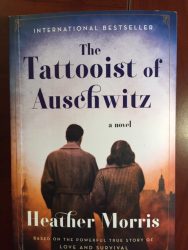Book review: THE TATTOOIST OF AUSCHWITZ
Perhaps because I lost 25 members of my family in the Holocaust, or maybe because I was one of Europe’s “hidden children” during World War II, I am obsessed with the Holocaust. From the time I first began doing research for my first memoir, PRAGUE: MY LONG JOURNEY HOME, I’ve read nearly a hundred books–mostly nonfiction, but also some fiction–about that horrific piece of history. Thus, when I discovered Heather Morris’ THE TATTOOIST OF AUSCHWITZ, I had to read it. Although the book is based on a true story, it is important to remember that its cover marks it clearly as “a novel.”
Lale Sokolov, the book’s hero, is a Slovak who is transported to Auschwitz-Birkenau in 1942. There, his Nazi captors discover that he speaks a number of languages, an ability which saves his life. Because concentration camp prisoners’ identities were replaced by numbers tattooed on their arms upon arrival, and since the arrivals came from various countries throughout Europe, the Germans assigned Lale the job of explaining his actions before he punched the numbers into their skin. One day, Lale comforted a frightened young woman named Gita as he tattooed the number 32407 onto her arm. In that moment, he fell in love with Gita and vowed that both of them would survive and eventually marry. During the intervening two-and-a-half years, Lale witnessed horrific atrocities. He used his privileged position to obtain money and jewelry taken from murdered prisoners and exchanged them for food that kept both himself and his fellow prisoners alive. He volunteered for any job that would keep him away from death in a crematorium.
The book tells a poignant story, one that is often moving–filled with courage, determination, and love for a woman the hero hardly knows. Yet, as I read the book, something continued to bother me. The author’s description of daily life in Auschwitz was at odds with my concept of it, based on the many books I had read previously and descriptions by survivors whom I have known. Was there really as much laxity by the SS and the kapos as is depicted here? Was Lale really able to talk and smuggle with non-prisoner workers inside the camp? Did prisoners socialize with one another at the end of the day? Could Lale and Gita have made love under the Nazis’ eyes? Something did not ring true for me.
But then I came back to realizing that the book is categorized “a novel.” The author spent many weeks interviewing Lale Sokolov. As she tells us in the Epilogue, Lale was most concerned about being considered a collaborator in the camp. It is quite possible, and perhaps probable, that he fictionalized parts of the story in order to make himself appear more of a humanitarian who helped his fellow inmates. Perhaps Heather Morrow told the story exactly as Lale Sokolov told it, but she chose to brand it as fiction because she may have suspected a bit of brandishing. Nevertheless, the story is both interesting and inspiring. Anyone who survived the horror of Auschwitz is a hero.
